Experimental Study on Long-Term Mechanical Properties and Durability of Waste Glass Added to OPC Concrete
Abstract
:1. Introduction
2. Materials and Methods
2.1. Materials
2.2. Methods
3. Results and Discussion
3.1. Mechanical Performance
3.2. Durability Performance
3.2.1. Chloride Ion Attack
3.2.2. Freeze–Thaw Cycling
- Mass loss rate
- 2.
- Relative loss of dynamic modulus
4. Conclusions
- The sole addition of WGP led to a reduction in the early-age compressive strength of the concrete. The volcanic ash effect mainly occurred after 28 d. In the case of dual admixture, concrete will enter a period of rapid strength growth in advance. When the total dosage was 30%, a 1:1 ratio of WGP to mineral admixture yielded a higher compressive strength, with the G−S group specimens exhibiting superior compressive strength compared to the G−F group.
- Predictions of compressive strength variation with age were conducted using a time-dependent model. It was found that as age increases, compressive strength shows an overall increasing trend. The greater the dosage of glass powder, the larger the slope, and the faster the rate of strength growth. The average coefficient of determination (R2) for the regression equation of the time-dependent model was 0.92, indicating that the model can be used to predict compressive strength values at different ages.
- Both sole and dual admixture concrete showed improved resistance to chloride ion erosion when the total dosage was 30%. When the glass powder was solely added at a dosage of 30%, the chloride ion diffusion coefficient was the lowest. In the case of dual admixture, the higher the dosage of glass powder, the stronger the resistance to chloride ion erosion, showing an overall positive correlation.
- In both sole and dual admixture concrete, the overall frost resistance tended to decrease with an increase in the dosage of glass powder. When the total dosage was 30%, both the G−F and G−S groups exhibited improved frost-resistance characteristics. The optimal frost resistance was achieved when the glass powder and mineral admixture each accounted for 15%.
Author Contributions
Funding
Institutional Review Board Statement
Informed Consent Statement
Data Availability Statement
Acknowledgments
Conflicts of Interest
References
- Ali, M.B.; Saidur, R.; Hossain, M.S. A review on emission analysis in cement industries. Renew. Sustain. Energy Rev. 2011, 15, 2252–2261. [Google Scholar] [CrossRef]
- Deng, Q.; Zou, S.; Xi, Y.; Singh, A. Development and Characteristic of 3D-Printable Mortar with Waste Glass Powder. Buildings 2023, 13, 1476. [Google Scholar] [CrossRef]
- Mark, B.; Luca, V. Strength performance and life cycle assessment of high-volume low-grade kaolin clay pozzolan concrete: A Ghanaian scenario. Case Stud. Constr. Mater. 2022, 17, e01679. [Google Scholar]
- Lilis, N.; Eko, H.; Wahyu, S.; Imron, S.; Eka, J.F. Environmental impact analysis of PCC cement products (Portland Composite Cement) using LCA (Life Cycle Assessment). IOP Conf. Ser. Earth Environ. Sci. 2023, 1190, 012003. [Google Scholar]
- Vishnu, T.B.; Lakshman, S.K. A study on the suitability of solid waste materials in pavement construction: A review. Int. J. Pavement Res. Technol. 2021, 14, 625–637. [Google Scholar] [CrossRef]
- Paris, J.M.; Roessler, J.G.; Ferraro, C.C.; DeFord, H.D.; Townsend, T.G. A review of waste products utilized as supplements to Portland cement in concrete. J. Clean. Prod. 2016, 121, 1–18. [Google Scholar] [CrossRef]
- Qaidi, S.; Najm, H.M.; Abed, S.M.; Özkılıç, Y.O.; Al Dughaishi, H.; Alosta, M.; Sabri, M.M.S.; Alkhatib, F.; Milad, A. Concrete Containing Waste Glass as an Environmentally Friendly Aggregate: A Review on Fresh and Mechanical Characteristics. Materials 2022, 15, 6222. [Google Scholar] [CrossRef]
- Rajabipour, F.; Maraghechi, H.; Fischer, G. Investigating the Alkali-Silica Reaction of Recycled Glass Aggregates in Concrete Materials. J. Mater. Civ. Eng. 2010, 22, 1201–1208. [Google Scholar] [CrossRef]
- Mageswari, M.; Vidivelli, B. The Use of Sheet Glass Powder as Fine Aggregate Replacement in Concrete. Open Civ. Eng. J. 2010, 4, 65–71. [Google Scholar] [CrossRef]
- Saccani, A.; Bignozzi, M.C. ASR expansion behavior of recycled glass fine aggregates in concrete. Cem. Concr. Res. 2009, 40, 531–536. [Google Scholar] [CrossRef]
- Perkins, G.D. Development of Concrete Containing Waste Glass; University of Glamorgan: Pontypridd, Wales, 2008. [Google Scholar]
- Wojciech, S.; Łukasz, G.; Grzegorz, M.; Zdzisław, P. Influence of Waste Glass Powder Addition on the Microstructure and Mechanical Properties of Autoclaved Building Materials. Materials 2022, 15, 434. [Google Scholar]
- Wang, H.Y.; Huang, W.L. Durability of self-consolidating concrete using waste LCD glass. Constr. Build. Mater. 2010, 24, 1008–1013. [Google Scholar] [CrossRef]
- Chidiac, S.E.; Mihaljevic, S.N. Performance of dry cast concrete blocks containing waste glass powder or polyethylene aggregates. Cem. Concr. Compos. 2011, 33, 855–863. [Google Scholar] [CrossRef]
- Saribiyik, M.; Piskin, A.; Saribiyik, A. The effects of waste glass powder usage on polymer concrete properties. Constr. Build. Mater. 2013, 47, 840–844. [Google Scholar] [CrossRef]
- Aliabdo, A.A.; Elmoaty, A.E.M.A.; Aboshama, A.Y. Utilization of waste glass powder in the production of cement and concrete. Constr. Build. Mater. 2016, 124, 866–877. [Google Scholar] [CrossRef]
- Ramakrishnan, K.; Pugazhmani, G.; Sripragadeesh, R.; Muthu, D.; Venkatasubramanian, C. Experimental study on the mechanical and durability properties of concrete with waste glass powder and ground granulated blast furnace slag as supplementary cementitious materials. Constr. Build. Mater. 2017, 156, 739–749. [Google Scholar] [CrossRef]
- Kim, S.-K.; Hong, W.-K. High Sulfate Attack Resistance of Reinforced Concrete Flumes Containing Liquid Crystal Display (LCD) Waste Glass Powder. Materials 2019, 12, 2031. [Google Scholar] [CrossRef]
- Hwang, S.S.; Moreno Cortés, C.M. Properties of mortar and pervious concrete with co-utilization of coal fly ash and waste glass powder as partial cement replacements. Constr. Build. Mater. 2020, 270, 121415. [Google Scholar] [CrossRef]
- Diana, M.; Anna, M.K.; Kristina, F.; Tereza, P.; Petr, H. Waste Glass Powder Reusability in High-Performance Concrete: Leaching Behavior and Ecotoxicity. Materials 2021, 14, 4476. [Google Scholar]
- Ahmad, J.; Martínez-García, R.; de-Prado-Gil, J.; Irshad, K.; El-Shorbagy, M.A.; Fediuk, R.; Vatin, N.I. Concrete with Partial Substitution of Waste Glass and Recycled Concrete Aggregate. Materials 2022, 15, 430. [Google Scholar] [CrossRef]
- İhsan, Ç.A.; Onuralp, Ö.Y.; Özer, Z.; Memduh, K.; Shaker, Q.; Jawad, A.; Doru, B.D.; Costica, B. Mechanical Behavior of Crushed Waste Glass as Replacement of Aggregates. Materials 2022, 15, 8093. [Google Scholar]
- Soliman, N.A.; Tagnit-Hamou, A. Using glass sand as an alternative for quartz sand in UHPC. Constr. Build. Mater. 2017, 145, 243–252. [Google Scholar] [CrossRef]
- Afshinnia, K.; Rangaraju, P.R. Impact of combined use of ground glass powder and crushed glass aggregate on selected properties of Portland cement concrete. Constr. Build. Mater. 2016, 117, 263–272. [Google Scholar] [CrossRef]
- Ahmad, J.; Zhou, Z.; Usanova, K.I.; Vatin, N.I.; El-Shorbagy, M.A. A Step towards Concrete with Partial Substitution of Waste Glass (WG) in Concrete: A Review. Materials 2022, 15, 2525. [Google Scholar] [CrossRef]
- Más-López, M.I.; García del Toro, E.M.; García-Salgado, S.; Alcala-Gonzalez, D.; Pindado, S. Application of Concretes Made with Glass Powder Binder at High Replacement Rates. Materials 2021, 14, 3796. [Google Scholar] [CrossRef]
- Rakesh Sakale, S.J.; Singh, S. Experimental Investigation on Strength of Glass Powder Replacement by Cement in Concrete with Different Dosages. Int. J. Sci. Technol. Eng. 2016, 2, 76. [Google Scholar]
- Diao, Y.; Chen, L.; Huang, Y. Experimental Study on Mechanical Properties of Concrete Containing Waste Glass and Its Application on Concrete-Filled Steel Tubular Columns. Processes 2023, 11, 975. [Google Scholar] [CrossRef]
- Omer, B.; Saeed, J. Long-Term Effect of Different Particle Size Distributions of Waste Glass Powder on the Mechanical Properties of Concrete. Archit. Civ. Eng. Environ. 2020, 13, 61–75. [Google Scholar] [CrossRef]
- Balasubramanian, B.; Gopala Krishna, G.V.T.; Saraswathy, V.; Srinivasan, K. Experimental investigation on concrete partially replaced with waste glass powder and waste E-plastic. Constr. Build. Mater. 2021, 278, 122400. [Google Scholar] [CrossRef]
- Wang, Y.; Wu, F.; Zhang, Z.; Lin, J.; Bao, L. Study on the influence of waste glass powder replacing fly ash on the performance of concrete. J. Phys. Conf. Ser. 2023, 2539, 012026. [Google Scholar] [CrossRef]
- Kumar, K.; Dixit, S.; Arora, R.; Vatin, N.I.; Singh, J.; Soloveva, O.V.; Ilyashenko, S.B.; John, V.; Buddhi, D. Comparative Analysis of Waste Materials for Their Potential Utilization in Green Concrete Applications. Materials 2022, 15, 4180. [Google Scholar] [CrossRef] [PubMed]
- Mohammadyan-Yasouj, S.E.; Ghaderi, A. Experimental investigation of waste glass powder, basalt fibre, and carbon nanotube on the mechanical properties of concrete. Constr. Build. Mater. 2020, 252, 119115. [Google Scholar] [CrossRef]
- Amin, M.; Zeyad, A.M.; Tayeh, B.A.; Agwa, I.S. Effect of Glass Powder on High-Strength Self-Compacting Concrete Durability. Key Eng. Mater. 2023, 945, 117–127. [Google Scholar] [CrossRef]
- Tran, T.M.; Trinh, H.T.M.K.; Nguyen, D.; Tao, Q.; Mali, S.; Pham, T.M. Development of sustainable ultra-high-performance concrete containing ground granulated blast furnace slag and glass powder: Mix design investigation. Constr. Build. Mater. 2023, 397, 132358. [Google Scholar] [CrossRef]
- Peng, L.; Zhao, Y.; Ban, J.; Wang, Y.; Shen, P.; Lu, J.X.; Poon, C.S. Enhancing the corrosion resistance of recycled aggregate concrete by incorporating waste glass powder. Cem. Concr. Compos. 2023, 137, 104909. [Google Scholar] [CrossRef]
- JGJ 55-2011; Specification for Mix Proportion Design of Ordinary Concrete. China Architecture and Construction Press: Beijing, China, 2011.
- JTG E30-2005; Test Methods of Cement and Concrete for Highway Engineering. Institute of Highway Science, Ministry of Communications, China: Beijing, China, 2005.
- Bameri, M.; Rashidi, S.; Mohammadhasani, M.; Maghsoudi, M.; Madani, H.; Rahmani, F.; Černý, R. Evaluation of Mechanical and Durability Properties of Eco-Friendly Concrete Containing Silica Fume, Waste Glass Powder, and Ground Granulated Blast Furnace Slag. Adv. Mater. Sci. Eng. 2022, 2022, 2730391. [Google Scholar] [CrossRef]
- Marathe, S.; Mithanthaya, I.R.; Shenoy, R.Y. Durability and microstructure studies on Slag-Fly Ash-Glass powder based alkali activated pavement quality concrete mixes. Constr. Build. Mater. 2021, 287, 123047. [Google Scholar] [CrossRef]
- Nai-qian, F.; Feng, X. Chlorine ion permeability and electrical conductance of high performance concrete. Concrete 2001, 23, 3–7. [Google Scholar]
- Mousavinezhad, S.; Gonzales, G.J.; Toledo, W.K.; Garcia, J.M.; Newtson, C.M.; Allena, S. A Comprehensive Study on Non-Proprietary Ultra-High-Performance Concrete Containing Supplementary Cementitious Materials. Materials 2023, 16, 2622. [Google Scholar] [CrossRef]
- Szweda, Z.; Golaszewski, J.; Ghosh, P.; Lehner, P.; Konecny, P. Comparison of Standardized Methods for Determining the Diffusion Coefficient of Chloride in Concrete with Thermodynamic Model of Migration. Materials 2023, 16, 637. [Google Scholar] [CrossRef]


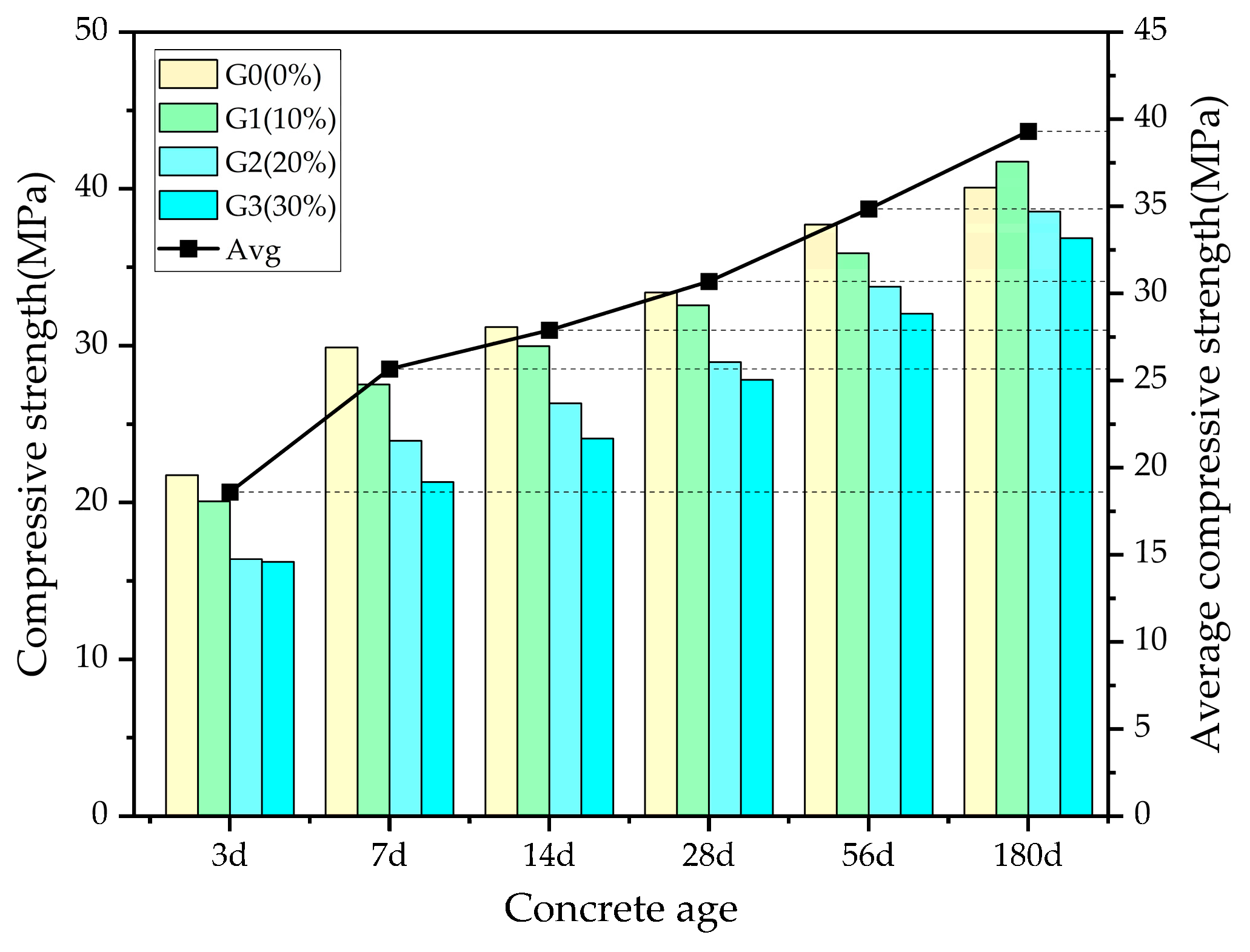
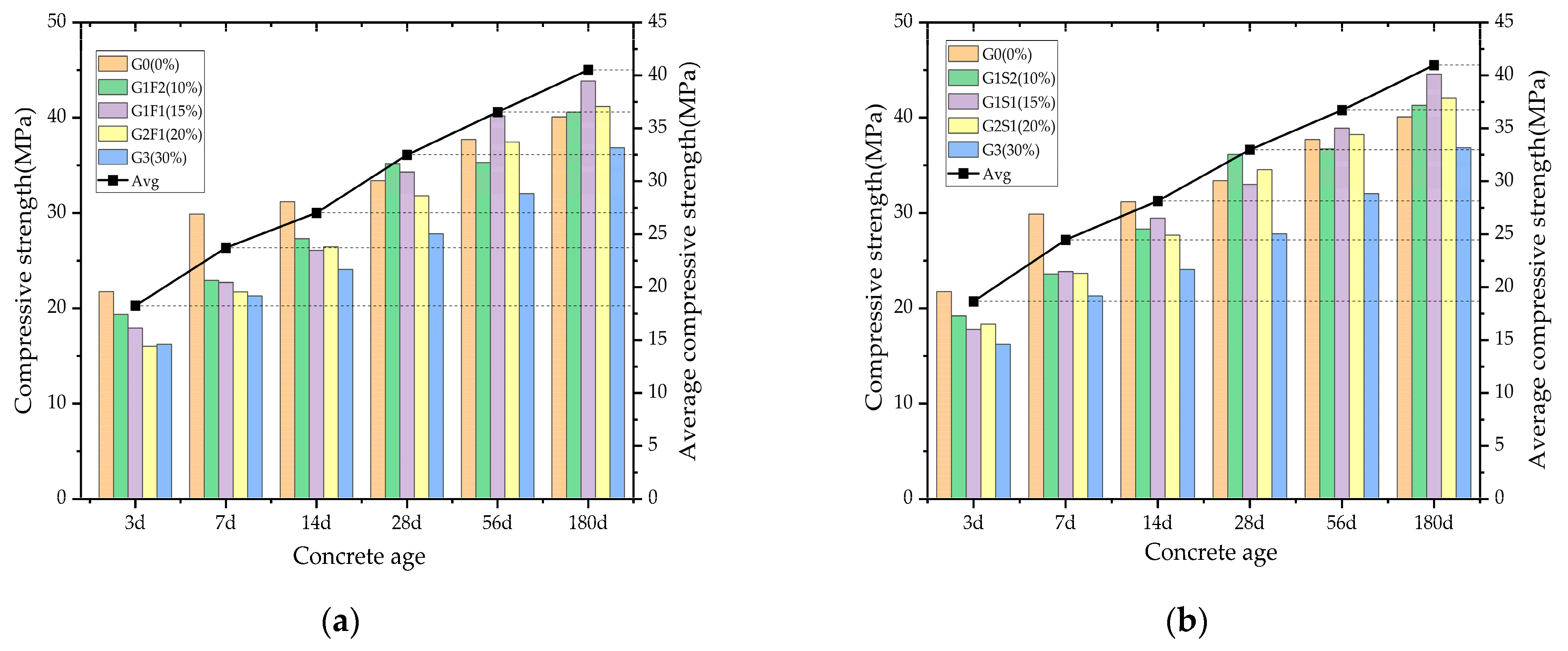
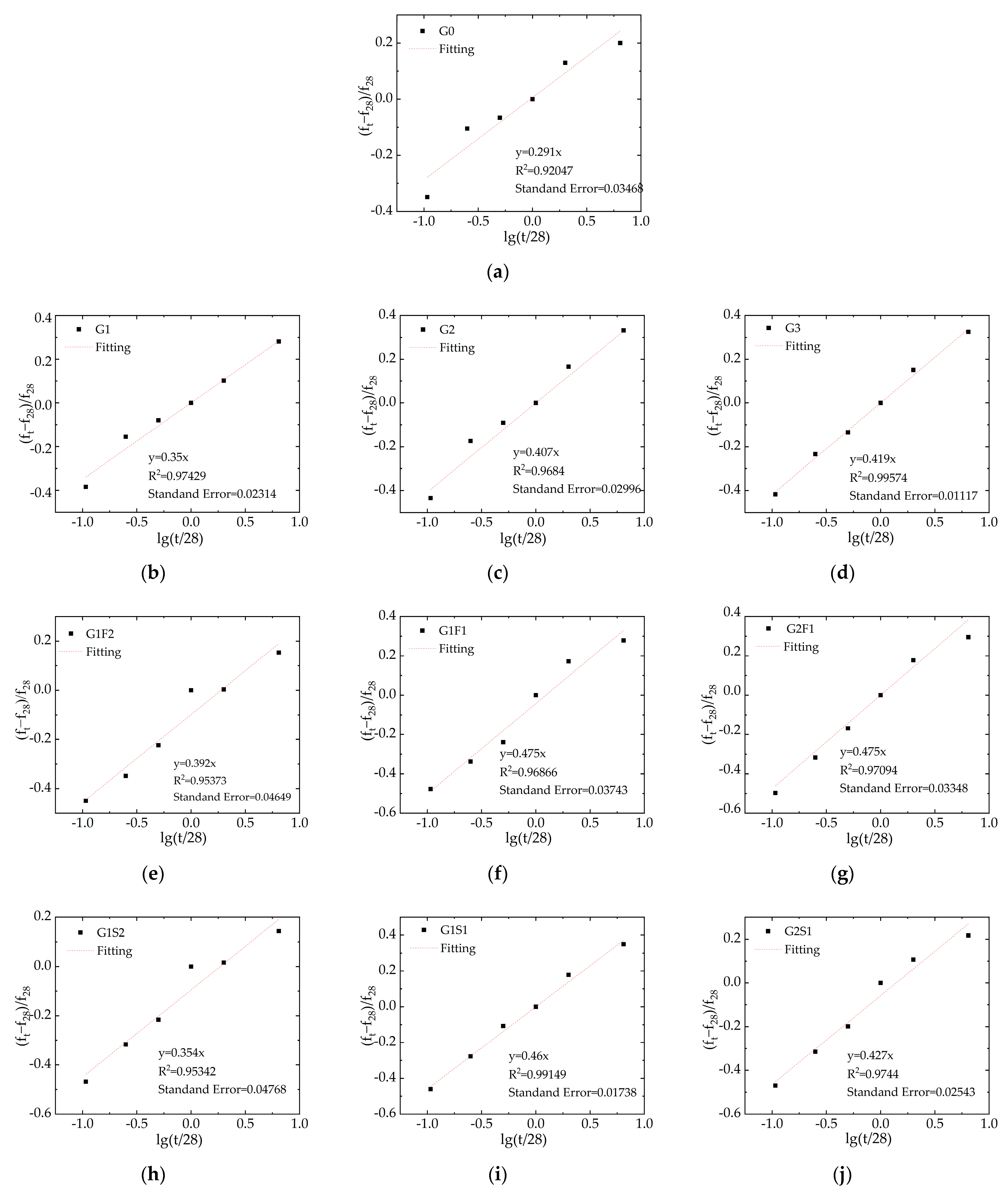
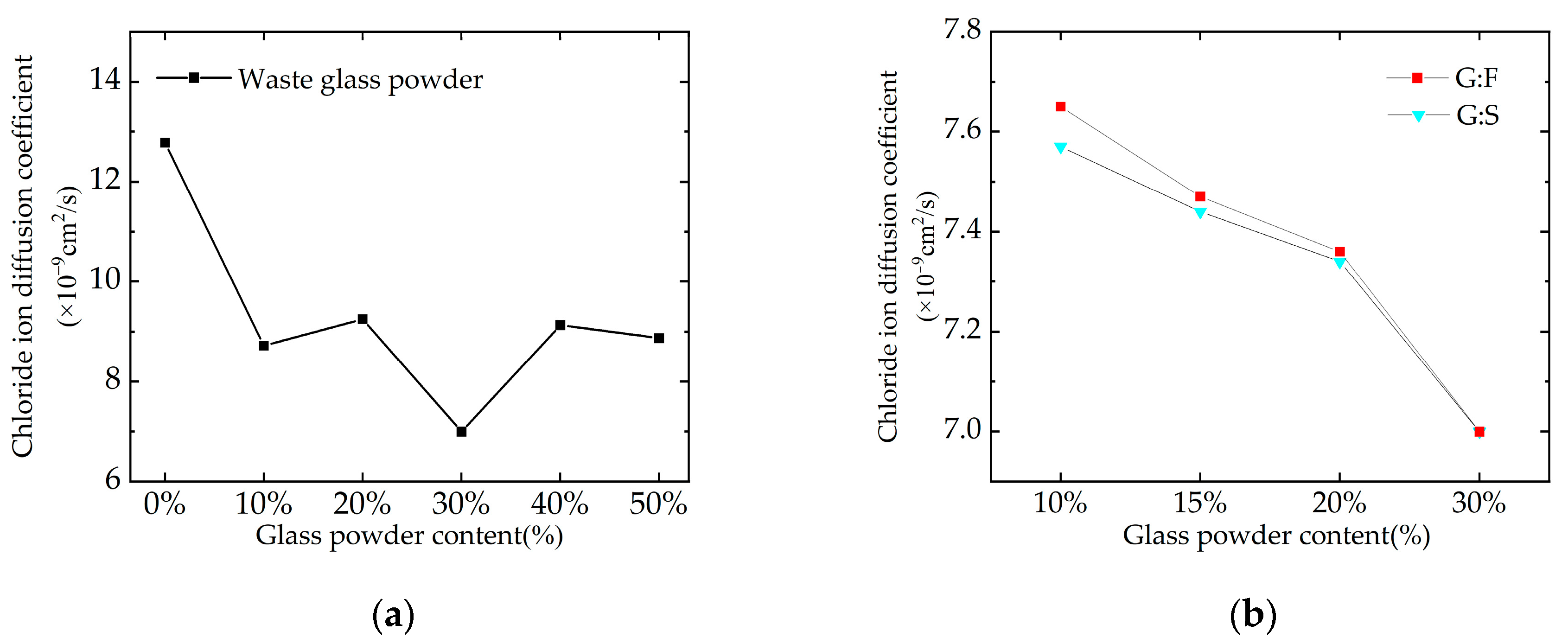
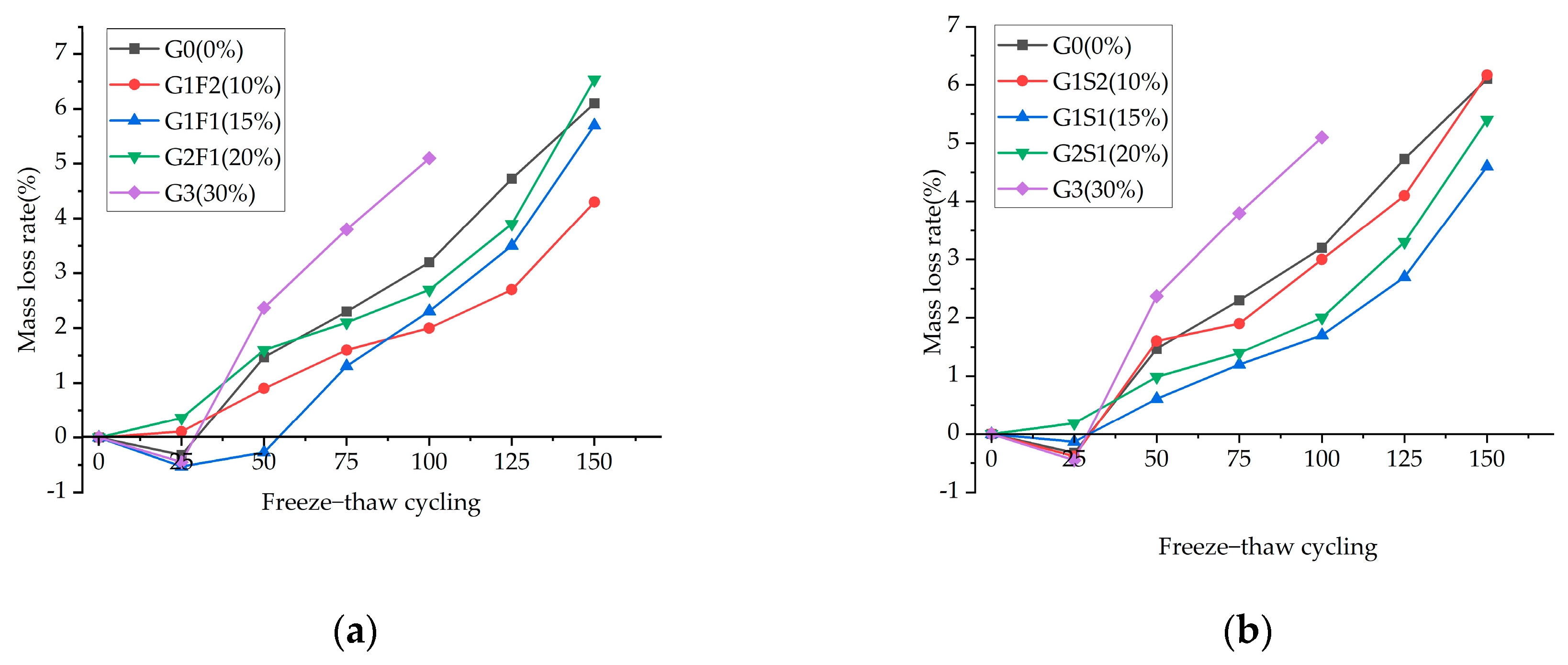
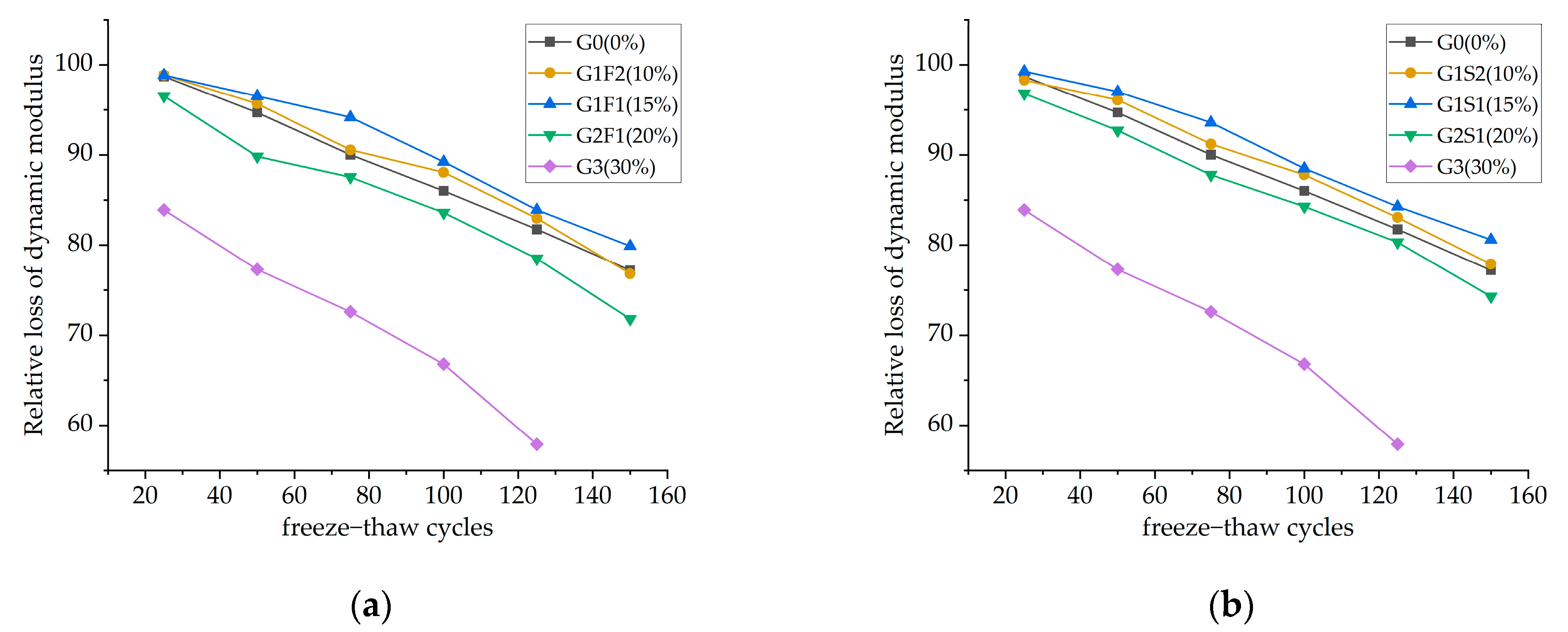
| Composition | SiO2 | Na2O | CaO | Al2O3 | K2O | Fe2O3 | MgO | SO3 | TiO2 |
|---|---|---|---|---|---|---|---|---|---|
| Unit (wt.%) | 67.79 | 13.89 | 11.37 | 3.51 | 0.87 | 0.53 | 0.62 | 0.80 | 0.15 |
| Performance | Specific Surface Area (m2/kg) | Flow Ratio (%) | Density (g/cm3) | Moisture Content (%) | Activity Index (%) | ||
| 7 d | 28 d | ||||||
| 429 | 98 | 3.1 | 0.45 | 84.2 | 98.5 | ||
| Composition | MgO | SiO2 | CaO | Al2O3 | Fe2O3 | SO3 | Loss on ignition (%) |
| Unit (wt.%) | 6.01 | 34.5 | 34 | 17.7 | 1.03 | 1.64 | 0.84 |
| Performance | Specific Surface Area (m2/kg) | Flow Ratio (%) | Density (g/cm3) | Moisture Content (%) | Activity Index (%) | ||
| 7 d | 28 d | ||||||
| 430 | 97 | 3.1 | 0.43 | 84.1 | 98.3 | ||
| Composition | CaO | SiO2 | Al2O3 | SO3 | Fe2O3 | MgO | Loss on ignition (%) |
| Unit (wt.%) | 34 | 34.2 | 17.6 | 1.62 | 1.01 | 6.21 | 0.87 |
| Code | Waste Glass Powder | Fly Ash | Slag Powder | Cement | Water | Sand | Stone |
|---|---|---|---|---|---|---|---|
| G0 | 0 | 0 | 0 | 355 | 163 | 625 | 1185 |
| G1 | 35.5 (10%) | 0 | 0 | 319.5 | 163 | 625 | 1185 |
| G2 | 71 (20%) | 0 | 0 | 284 | 163 | 625 | 1185 |
| G3 | 106.5 (30%) | 0 | 0 | 248.5 | 163 | 625 | 1185 |
| G4 | 142 (40%) | 0 | 0 | 142 | 163 | 625 | 1185 |
| G5 | 177.5 (50%) | 0 | 0 | 177.5 | 163 | 625 | 1185 |
| G1F2 | 35.5 (10%) | 71 (20%) | 0 | 248.5 | 163 | 625 | 1185 |
| G1F1 | 53.25 (15%) | 53.25 (15%) | 0 | 248.5 | 163 | 625 | 1185 |
| G2F1 | 71 (20%) | 35.5 (10%) | 0 | 248.5 | 163 | 625 | 1185 |
| G1S2 | 35.5 (10%) | 0 | 71 (20%) | 248.5 | 163 | 625 | 1185 |
| G1S1 | 53.25 (15%) | 0 | 53.25 (15%) | 248.5 | 163 | 625 | 1185 |
| G2S1 | 71 (20%) | 0 | 35.5 (10%) | 248.5 | 163 | 625 | 1185 |
| Experimental | Compressive Strength | Electrical Flux | Freeze-Thaw Cycling |
|---|---|---|---|
| Age (d) | 3, 7, 14, 28, 56, 180 | 56 | 60 |
| Groups | 60 | 8 | 10 |
| Quantities | 6 | 3 | 3 |
| Subtotal | 360 | 24 | 30 |
| Grand Total | 414 | ||
| Code | Fitting Model | R2 |
|---|---|---|
| G3 | 0.996 | |
| G1F1 | 0.969 | |
| G1S1 | 0.991 |
| Code | Electric Flux (C) | Chloride Ion Penetration Resistance Grade | Chloride Ion Diffusion Coefficient (×10−9 cm2/s) |
|---|---|---|---|
| G0 | 2073.65 | middle | 12.78 |
| G1 | 1248.45 | low | 8.72 |
| G2 | 1356.17 | low | 9.25 |
| G3 | 899.79 | extremely low | 7.00 |
| G4 | 1331.78 | low | 9.13 |
| G5 | 1278.93 | low | 8.87 |
| G1S2 | 1014.71 | low | 7.57 |
| G1S1 | 987.34 | extremely low | 7.44 |
| G2S1 | 968.68 | extremely low | 7.34 |
| G1F2 | 1030.97 | low | 7.65 |
| G1F1 | 994.38 | extremely low | 7.47 |
| G2F1 | 972.02 | extremely low | 7.36 |
Disclaimer/Publisher’s Note: The statements, opinions and data contained in all publications are solely those of the individual author(s) and contributor(s) and not of MDPI and/or the editor(s). MDPI and/or the editor(s) disclaim responsibility for any injury to people or property resulting from any ideas, methods, instructions or products referred to in the content. |
© 2023 by the authors. Licensee MDPI, Basel, Switzerland. This article is an open access article distributed under the terms and conditions of the Creative Commons Attribution (CC BY) license (https://creativecommons.org/licenses/by/4.0/).
Share and Cite
Zhu, J.; Meng, X.; Wang, B.; Tong, Q. Experimental Study on Long-Term Mechanical Properties and Durability of Waste Glass Added to OPC Concrete. Materials 2023, 16, 5921. https://doi.org/10.3390/ma16175921
Zhu J, Meng X, Wang B, Tong Q. Experimental Study on Long-Term Mechanical Properties and Durability of Waste Glass Added to OPC Concrete. Materials. 2023; 16(17):5921. https://doi.org/10.3390/ma16175921
Chicago/Turabian StyleZhu, Jichao, Xinyu Meng, Baoyuan Wang, and Qianhao Tong. 2023. "Experimental Study on Long-Term Mechanical Properties and Durability of Waste Glass Added to OPC Concrete" Materials 16, no. 17: 5921. https://doi.org/10.3390/ma16175921
APA StyleZhu, J., Meng, X., Wang, B., & Tong, Q. (2023). Experimental Study on Long-Term Mechanical Properties and Durability of Waste Glass Added to OPC Concrete. Materials, 16(17), 5921. https://doi.org/10.3390/ma16175921





